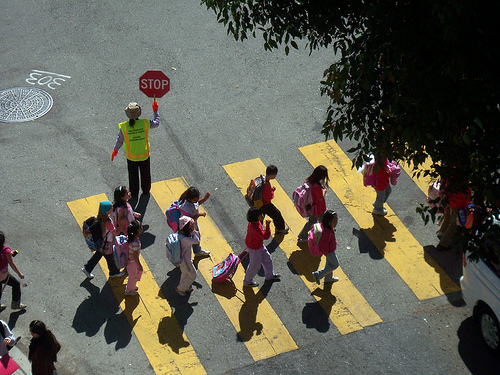Between 2005 and 2014, Congress will have spent at least $800 million on thousands of grants designed to encourage kids to walk and bike to school. The Safe Routes to School program’s list of grants reveals tax-paid expenditures on everything from bicycle rodeos, paper sneakers, “I’m Safe” bookmarks, and LED-studded stop signs to marketing campaigns, police overtime, and safety materials designed for the Amish.
SRTS was bundled into the 2005 legislation known as SAFETEALU, “the epitome of pork,” said Randal O’Toole, a senior fellow at the Cato Institute. It included more than 7,000 earmarks at a cost of $24 billion, and was sponsored by Alaska Rep. Don Young, infamous for his “bridge to nowhere” earmark.
“Safe Routes to Schools is a local function, not a federal function,” O’Toole said. “It was passed in an era when fiscal conservatives supposedly had more say over what is happening than now. They failed to take into account that they won’t always be in charge.”
The money for SRTS comes from the federal gas tax, but now comes directly from borrowed dollars because Congress has failed to pass a budget for two years. This means program spending is stuck at 2009 levels, which is higher than tax revenue, O’Toole said.
Duplicating Private Activity
Safe Kids Walk This Way is another initiative older than SRTS that does many of the same things but thrives on volunteers and donations. Six hundred Safe Kids coalitions across the U.S. recruit volunteers to spruce up cross walks, encourage kids to walk and bike to school, teach travel safety, and monitor youngsters as they walk to school, said Joy Bates Boyle, a spokesman for Safe Kids Worldwide.
The organization partners with private companies like Johnson & Johnson and FedEx to find volunteers and raise money. In 2011, for example, nearly 300,000 kids in 1,000 schools participated in International Walk to School Day events hosted by Safe Kids partners. The organization also studies traffic and safety to provide schools and communities model environments and traffic patterns.
A 2005 Independence Institute study noted that efforts to create more walkable communities can be counterproductive and create more accidents because some urban planners attempt to discourage driving at the expense of safety.
Federal Grants Often Inefficient
Federal transportation grants often ultimately cost taxpayers and local citizens much more than if they had tackled the problem locally, O’Toole said. First, this is because the people spending the money are not spending their own, so they consider $850 for bookmarks a good use of money, as happened in a Delaware SRTS grant. Second, this is so because certain grants discourage thrift.
A capital or competitive grant is “essentially a big pot of money and states and cities that come up with the most expensive projects get the most,” O’Toole said. “It becomes an incentive to waste money—cities are trying to find the most expensive projects they can instead of the cheapest.”
Another problem with federal transit grants, he said, is that the money for these comes from gas taxes, which were originally aimed at fixing the roads cars use. Using those funds on other pursuits like SRTS means less money for roads initially and higher gas taxes later to replace the diverted funds.
Ultimately, O’Toole said, transit projects work best when the people using a service are those directly paying for or volunteering and recruiting volunteers to create it.
“Certainly cities can’t make safe routes to school without the federal government,” he said, tongue in cheek.
Sampling of Safe Routes to School Projects:
- $5,106,924 for signs and pavement markings in Bradenton, Florida in 2010
- $28,634 for bicycle rodeos in Bradenton, Florida in 2007
- $48,875 for a bicycle rodeo or bike training in Aurora, Illinois in 2007
- $1,100 for posters and paper sneakers in Wilmington, Delaware in 2010
- $1,104,453 for a “team of engineers, planners, and bicycle/pedestrian experts” to work with schools in reducing car speeds and improving pedestrian and bicycle access to schools statewide in Massachusetts in 2010
- $5,560 for “I’m Safe” bookmarks in Dover, Delaware in 2009
- $385 for staff Walk to School Month polos in Dover, Delaware in 2009
- $5,000 for a bike obstacle course and walking school bus in Boise, Idaho in 2010
- $50,000 to start a walking school bus program in Arlington Heights, Illinois in 2007
- $48,009 to create “encouragement” signs, have law enforcement slow traffic, and develop safety materials for the Amish in Millersburg, Ohio in 2010.
Image by jeweledlion.





